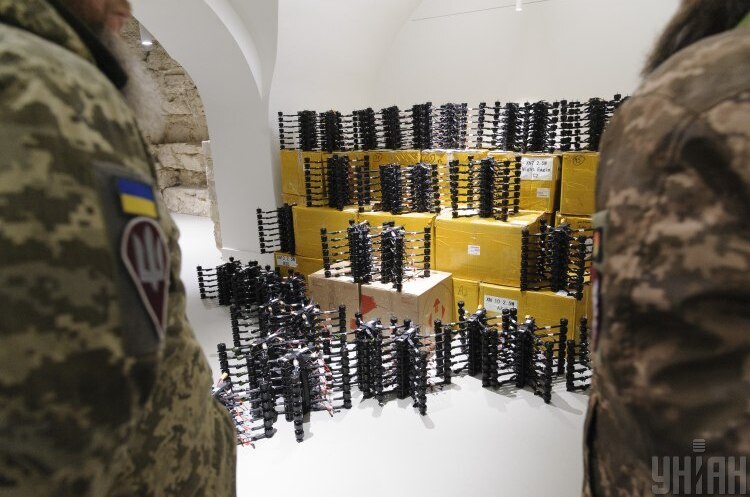Lords of the Swarm
Swarmer allows a single pilot to control 10-15 UAVs simultaneously

Ukrainian AI startup Swarmer, founded by Sergey Kuprienko and Alex Fink in May 2023, is developing an artificial intelligence system to control a swarm of drones. The team is creating a solution that can plan and execute missions at a distance of tens of kilometers within a few hours. The startup has recently rolled out the first version with simple operations for combat use. A unit of the Armed Forces of Ukraine is already using the solution for its unmanned aerial vehicles (UAVs). The plan is to create a more sophisticated system by the end of the year. How does the team plan to do this? What can this AI solution do now? And do they need new investments?
In this blog, Mind.ua talked to Swarmer’s top executives about this and many other topics.
What can Swarmer do?
Swarmer's Styx AI product allows one to control several drones at once, which increases the efficiency of a single pilot. The first version operates within an hour of flying distance. Currently, the solution can already combine 10-15 drones into a swarm. In the near future, the team wants to train the system to plan complex missions with target transfers, hits, and confirmations. The most difficult part, according to the founders, is to turn drones “into super-intelligent creatures that fly in swarms, adapt to changes, and effectively perform the tasks set by humans.” Technically, the startup can launch 100 drones, but the main challenge is to teach them to communicate with each other. “F-16 pilots take 10 years to learn how to fly in a group,” says Swarmer CPO Oleksandr Arapov.
The software suggests the most optimal way for target reach and acquisition, but a human still makes the final decision to strike. “The basic principle of drone swarm management is that a person should be responsible for key decisions,” explains Kuprienko.
The solution can work with all types of drones, but to successfully pass the first combat test, the system was limited. The first version works with only one type of drone. “We had to cut out some things on purpose. The system is capable of performing complex operations on many drones, but to safely pass the first combat test and pass the software solution to the pilots, we cut a lot of things. We made a big red button that triggers several safeguards," Arapov recalls. This option allows the drone to be saved and returned home.
According to Kuprienko, the system has a flexible mix of algorithmic methods behind it. “We mix together an algorithmic approach that sets the framework for what the model can and cannot do. The decisions are made inside this approach. We have to be sure that the system is safe and predictable for the person using it,” the co-founder says.
Swarmer’s AI has been trained on 4000 missions. The classic problem in training an AI model is data. “Much more money was spent on working with data. We mostly trained the model on open data. The difficulty lies in its quality. In addition to open sources, we have drone operations data thanks to a partnership with one of the drone developers,” Kuprienko clarifies.
How was Swarmer tested?
First, the tests were held in a simulator that the team made on their own. Then – three weeks of living at the field base with the involvement of drone pilots. “We have hundreds of test flight records in our dataset. During the summer of 2023, the team and I got sunburned four times (and even my car) at the polygon,” Kuprienko recalls.
Combat use became the final stage of testing. “It took us a month and a half. We were constantly postponing combat use. We wanted to make sure that the solution is understandable for the military and will work in their parameters," says the co-founder. The team familiarizes pilots with the system, but the process is very quick. “The pilots are usually young and advanced, who have seen more complex systems, and they quickly start working with our solution," Kuprienko explains.
Kuprienko does not comment on how Swarmer managed to get to the battlefield. However, he advises: “If you are a MilTech startup, you need to do it as quickly as possible. If you don't know anyone in the military, go to hackathons, join the Army of Drones, or just ‘knock’ on Facebook to people who are involved in this. There are a lot of people in the Defense Ministry, the Ministry of Digital Transformation, and Aerial Intelligence who are interested in getting you in touch with people in the army who can help test the idea as soon as possible,” Kuprienko says.
What was the cost of development?
Swarmer does not disclose the total amount of money invested in the product or the names of investors. The co-founders only say that several hundred thousand dollars have been invested, and at least three funds were involved. The only investment the startup has publicly reported is from the D3 fund and accelerator. The startup invested the funds in the team and the creation of a product prototype.
The team did not apply for grants: at the time of their launch (late summer 2023), they needed much more money than they could get on a grant basis. “We did a lot of homework and spent a significant amount of our own money. We realized we needed much more money than we could get as a grant in Ukraine. $25,000 from Brave1 would have been enough for a week or two of work. That's why we didn't even apply,” Kuprienko explains.
More investments are needed.
The startup is currently gearing up for a new round of investments. “We are trying to follow the format of a standard Western check for a seed round. That is… we will be talking about millions of dollars,” the co-founder comments. The team is working with several funds and expects most of the investors to come from the West. The startup expects to raise funds soon.
New developments in the pipeline.
Swarmer plans to use the investment to further develop their product. Two key technological modules need to be finalized: “Analysis and modeling of battlefield situations” (allows one to understand current events and predict future ones) and “Planning, execution, re-planning of swarm behavior.”
Kuprienko explains: “This is what distinguishes a swarm from a simple group of drones. It constantly analyzes the tasks performed, and when it receives new information, it re-plans the mission.” The team plans to complete the next version with complex operations within 6 months. “We are increasing the pace of work, which requires additional resources: funding and team expansion,” he comments.
A look at Swarmer’s competitors.
The development of the DELTA online system, which allows real-time battlefield monitoring and information exchange, took eight years, Kuprienko cites an example. “This system has become a standard used by everyone. If we manage to achieve a similar result in one year, I will consider myself to have achieved my life goal,” he explains.
According to Kuprienko, Swarmer has competitors in the market. However, the team is trying to assemble a single product using the solutions of different companies. “We take elements from Palantir, Shield.ai, add military software from Rheinmetall, and integrate innovations from Avalor.ai,” the co-founder says. In his opinion, the critical problem of most companies is that they were born in times of peace. “We learn more information in two hours of working with pilots and bring more value than a California startup in Santa Monica in two years. We are making a system that integrates into real combat conditions, not a theoretical situation,” he adds.
Why isn’t Swarmer abroad yet?
Right now, the main market Swarmer is focusing on is Ukraine. “For us, building a $1 billion company and winning the war is strategically much more important than building a $100 billion company and not winning,” Kuprienko says. The founders don't talk about their clients. “At this fundraising stage, we can't communicate about it,” Kuprienko summarizes.
If you have read this article to the end, we hope that means it was useful for you.
We work to ensure that our journalistic and analytical work is of high quality, and we strive to perform it as competently as possible. This also requires financial independence. Support us for only UAH 196 per month.
Become a Mind subscriber for just USD 5 per month and support the development of independent business journalism!
You can unsubscribe at any time in your LIQPAY account or by sending us an email: [email protected]


